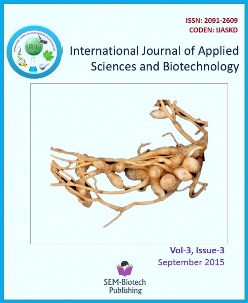Assessment of Heavy Metals in Roadside Surface Soil and Vegetation along Mubi – Michika Major Road in Adamawa State, Nigeria
DOI:
https://doi.org/10.3126/ijasbt.v3i3.12934Keywords:
Heavy Metals, Roadside, surface soils, vegetation and Mubi – MichikaAbstract
The study of heavy metals in environmental niches is essential, especially with their potential toxicity to human life. To identify the levels of heavy metals in roadside environment, samples of roadside soils and vegetation were collected from ten (10) towns along the Mubi - Michika major road which include Mubi, Mararaba, Dzakwa, Hildi, Uba, Kudzum, Dilchim, Bazza, Watu and Michika. Subsequently, the concentrations of heavy metals particularly Cu, Pb, Cr, Fe and Cd in the samples were analyzed using atomic absorption spectrophotometer (AAS). The result revealed that Cu, Pb, Cr, Fe, and Cd were present in the soil, at the mean concentration ranged of Cu (0.20±0.01 to 1.16±0.20%), Cd (0.04±0.03 to 0.13±0.05%), Zn (6.30±0.01 to 13.90±0.23%), Pb (1.32±0.03 to 5.63±0.04%), Fe (12.00±0.20 to 32.92±0.42%), and Cr (0.04±0.02 to 0.09±0.03%). The concentrations of the heavy metals in plant leaves samples ranged from Cu (0.01±0.03 to 0.93±0.01%), Cd (0.01±0.03 to 0.09±0.02%), Zn (2.40±0.03% to 7.10+0.14%), Pb (0.26±0.01 to 2.16±0.01%), Fe (5.10±0.01 to 15.00±0.14%) and Cr (0.01±0.03 to 0.03±0.13%). The Pb concentrations in both soil and plant leaves were found to be in excess of FAO/WHO recommended limits. While the levels of the other heavy metals in both soil and plants leaves were found to be within the FAO/WHO recommended limits. The high level of Pb indicates potential health risk for human through the food chain. From the study, the heavy metals pollutant in roadside soil and vegetation along Mubi-Michika roadside villages might originate from common anthropogenic source and high rate of human activities such as automobile emission.
Int J Appl Sci Biotechnol, Vol 3(3): 545-551




